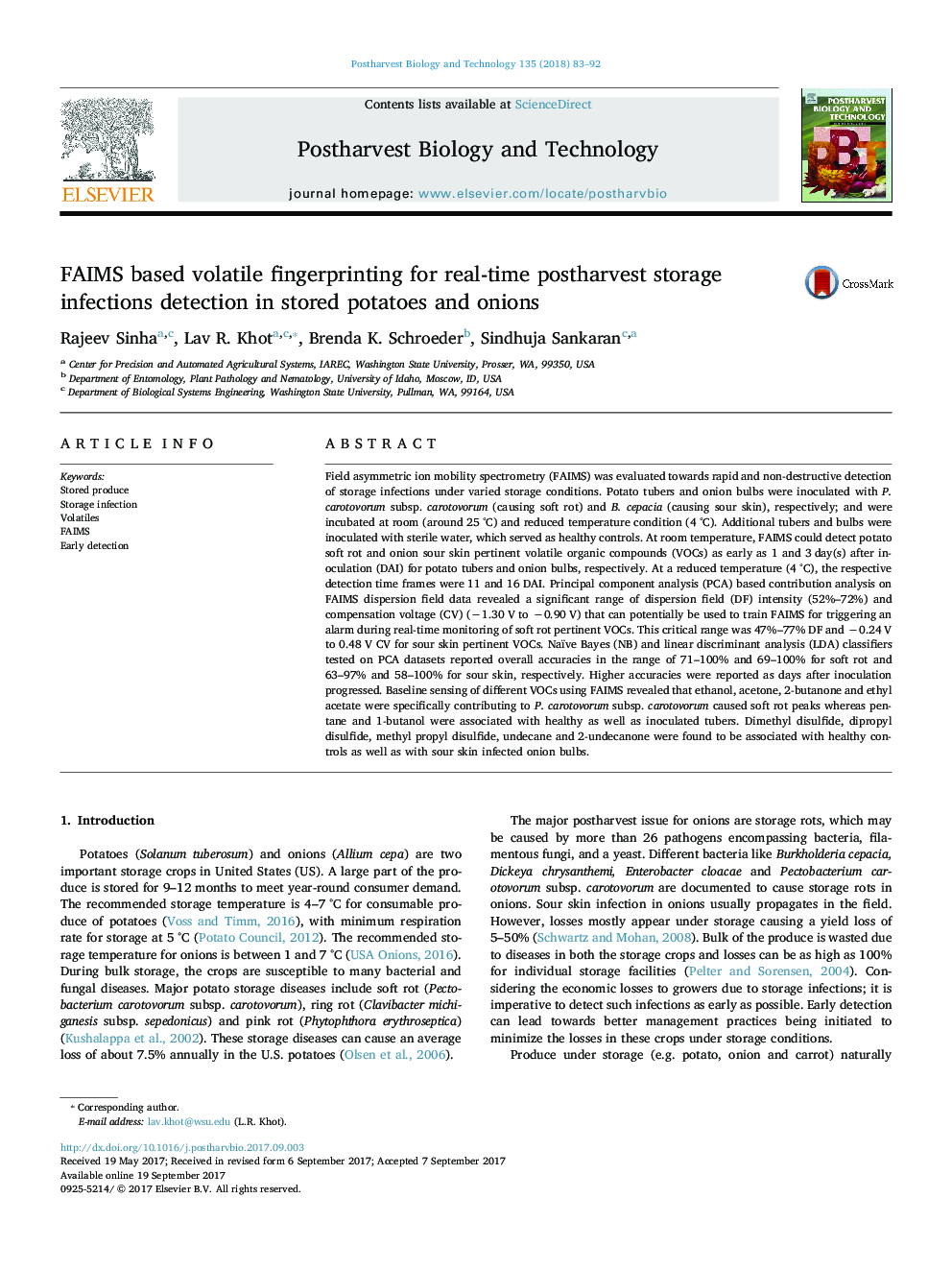| کد مقاله | کد نشریه | سال انتشار | مقاله انگلیسی | نسخه تمام متن |
|---|---|---|---|---|
| 5762631 | 1624959 | 2018 | 10 صفحه PDF | دانلود رایگان |
عنوان انگلیسی مقاله ISI
FAIMS based volatile fingerprinting for real-time postharvest storage infections detection in stored potatoes and onions
دانلود مقاله + سفارش ترجمه
دانلود مقاله ISI انگلیسی
رایگان برای ایرانیان
موضوعات مرتبط
علوم زیستی و بیوفناوری
علوم کشاورزی و بیولوژیک
علوم زراعت و اصلاح نباتات
پیش نمایش صفحه اول مقاله

چکیده انگلیسی
Field asymmetric ion mobility spectrometry (FAIMS) was evaluated towards rapid and non-destructive detection of storage infections under varied storage conditions. Potato tubers and onion bulbs were inoculated with P. carotovorum subsp. carotovorum (causing soft rot) and B. cepacia (causing sour skin), respectively; and were incubated at room (around 25 °C) and reduced temperature condition (4 °C). Additional tubers and bulbs were inoculated with sterile water, which served as healthy controls. At room temperature, FAIMS could detect potato soft rot and onion sour skin pertinent volatile organic compounds (VOCs) as early as 1 and 3 day(s) after inoculation (DAI) for potato tubers and onion bulbs, respectively. At a reduced temperature (4 °C), the respective detection time frames were 11 and 16 DAI. Principal component analysis (PCA) based contribution analysis on FAIMS dispersion field data revealed a significant range of dispersion field (DF) intensity (52%-72%) and compensation voltage (CV) (â1.30 V to â0.90 V) that can potentially be used to train FAIMS for triggering an alarm during real-time monitoring of soft rot pertinent VOCs. This critical range was 47%-77% DF and â0.24 V to 0.48 V CV for sour skin pertinent VOCs. Naïve Bayes (NB) and linear discriminant analysis (LDA) classifiers tested on PCA datasets reported overall accuracies in the range of 71-100% and 69-100% for soft rot and 63-97% and 58-100% for sour skin, respectively. Higher accuracies were reported as days after inoculation progressed. Baseline sensing of different VOCs using FAIMS revealed that ethanol, acetone, 2-butanone and ethyl acetate were specifically contributing to P. carotovorum subsp. carotovorum caused soft rot peaks whereas pentane and 1-butanol were associated with healthy as well as inoculated tubers. Dimethyl disulfide, dipropyl disulfide, methyl propyl disulfide, undecane and 2-undecanone were found to be associated with healthy controls as well as with sour skin infected onion bulbs.
ناشر
Database: Elsevier - ScienceDirect (ساینس دایرکت)
Journal: Postharvest Biology and Technology - Volume 135, January 2018, Pages 83-92
Journal: Postharvest Biology and Technology - Volume 135, January 2018, Pages 83-92
نویسندگان
Rajeev Sinha, Lav R. Khot, Brenda K. Schroeder, Sindhuja Sankaran,